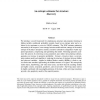282 search results - page 49 / 57 » On predicting secondary structure transition |
BMCBI
2004
13 years 7 months ago
2004
Background: Hidden Markov Models (HMMs) have proven very useful in computational biology for such applications as sequence pattern matching, gene-finding, and structure prediction...
NIPS
1998
13 years 9 months ago
1998
We introduce a novel framework for simultaneous structure and parameter learning in hidden-variable conditional probability models, based on an entropic prior and a solution for i...
GECCO
2005
Springer
14 years 1 months ago
2005
Springer
Given concentrations of metabolites over a sequence of time steps, the metabolic pathway prediction problem seeks a set of reactions and rate constants for them that could yield t...
RECOMB
2003
Springer
14 years 7 months ago
2003
Springer
We describe a novel method for detecting the domain structure of a protein from sequence information alone. The method is based on analyzing multiple sequence alignments that are ...
BMCBI
2006
13 years 7 months ago
2006
Background: The emerging field of integrative bioinformatics provides the tools to organize and systematically analyze vast amounts of highly diverse biological data and thus allo...

